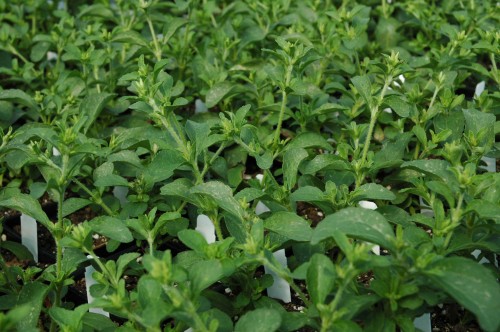Looking to replace sugar in your life? Try Stevia! Stevia is an herb with a naturally occurring sweetness that is between 40 and 300 times sweeter than sugar (depending on the strength of the plant and the method by which its sweeteners are extracted). The natural sweetness is derived from the plant’s glycosides, which is called Stevioside. Stevioside is intensely sweet-tasting, doesn’t break down at high temperatures, is not a mutagenic and will not cause cancer in humans. Whether extracted in liquid form or found in powdered form as an alternative to table sugar, Stevia shows to be a very valuable plant for many healthy reasons. Calorie free, this herbal substitute to weight-causing white sugar is also safe for diabetics. Because Stevia does not raise blood sugar levels, it seems to be a great alternative to sugar for diabetics, but consultation with a medical professional is advised before altering your diet. Studies also show that Stevia does not promote tooth decay and that it may in fact help prevent plaque, according to research done at Purdue University. This sweet herb is also antibacterial and may aid patients who suffer from hypertension.
Although growing Stevia from seed is a trying process due to difficult germination and a scarcity of seed, growing Stevia from established plants and harvesting at home is a cinch! This shrubby herb is a tender perennial in warmer zones and will thrive in full sun. It prefers loamy, well-drained soil and needs to be kept moist but not saturated with water. It can grow up to eighteen inches high and does great in the garden or potted in a container for easier accessibility. Stevia can be a great culinary herb for flavoring drinks and dishes, but will not caramelize like sugar, so you may want to leave it out of your meringues and other dishes that require caramelization. Try growing some today and you can easily harvest the plant’s natural sweetener with the following method:
Harvesting Natural Sweetener from Stevia Plants
Materials:
2 Cups Fresh Stevia leaves, washed
1 Measuring Cup
Coffee Filters
1 Sauce Pan
1 Cup Grain Alcohol (You can use Vodka, Scotch, Brandy or whatever you prefer)
1 Strainer
1 Knife
1 Glass bowl
Preparation:
1) Chop the fresh Stevia leaves well to release the natural sweeteners. This will allow the leaves to more easily break down and for more of the plant’s sweetness to be extracted during the distillation process.
2) Allow the chopped leaves to steep in one cup of your preferred grain alcohol for twenty-four hours, in a covered glass bowl. Don’t worry. The alcohol will later be cooked out of the mix, but allowing the leaves to “bathe” in stiff spirits will separate the plant’s chemical components, removing the natural stevioside that we want.
3) After about twenty-four hours, strain the mixture through a strainer lined with coffee filters. This will remove and unwanted leaves and other plant materials, allowing only the herb’s extract and the alcohol to pass through.
4) Add the extracted concoction to your sauce pan and heat on low. Be sure not to simmer or boil your extract, as you want it to be hot enough only for most of the alcohol to evaporate out.
5) Once the majority of the alcohol burns off, your result is a concentrated extraction of the herb’s natural sweetener.
6) Make sure to dilute with water before using, as this is a concentrated form of Stevia that will be very sweet and may overwhelm your dish. Dilute with one part Stevia extract, to three parts water.


The Growers Exchange makes it simple to have a sweet life,with out all the guilt.